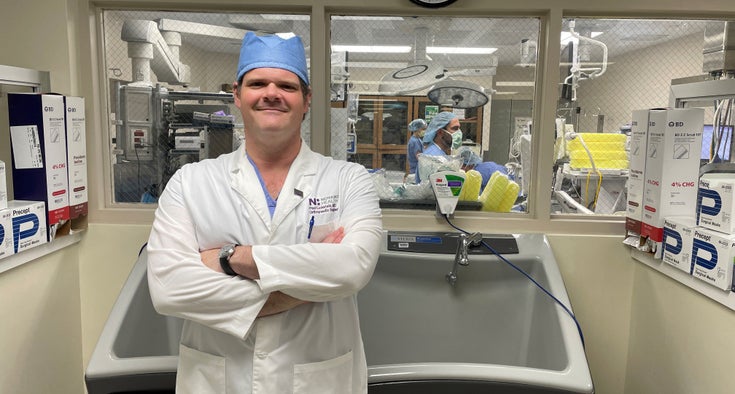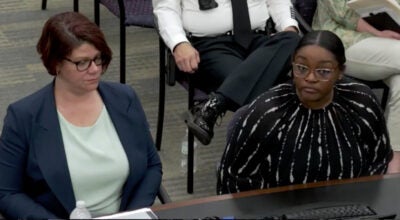Hip Op lifestyle: Novant Health doctor’s new study sheds light on hip replacements
Published 12:10 am Sunday, March 26, 2023

- Dr. Paul Lichstein, of Novant Health, is in charge of a new, comprehensive study on how hip replacements are treated. Submitted/Salisbury Post
SALISBURY — Dr. Paul Lichstein knows what it’s like to be a treated in a hospital and he carries that with him as he helps his own patients to this day. Lichstein is an orthopedic surgeon at Novant Health Orthopedics & Sports Medicine — Salisbury who specializes in adult reconstruction. While doing his medical school rotation in Virginia, Lichstein collided with an 18-wheeler late at night. He dislocated his hip and broke his pelvis where he was taken to surgery in Winston Salem.
“It was the singularity of my life for about a year and half, recovering from this operation and the impact that it had on myself, my career, my family, my loved ones, everything,” Lichstein said.
His road to recovery was long, but successful. With his medical background, he realized first hand the significance of the kind of work that he wanted to go into has on people. That “deep-seated, personal motivation” is what still drives him as a doctor.
“I got to the point where I was seeing a light at the end of the tunnel, I understood that there was a huge amount of responsibility that comes with that and I wanted to accept that responsibility,” Lichstein said.
Lichstein comes from a family of doctors. He grew up in Greenville where both his parents practiced medicine as well as his grandfather. “Medicine was kind of in the background, and particularly surgery, through out my entire childhood. The comforting, familiar backdrop of a lot of my experiences.”
Still, he didn’t feel any pressure from his family to get into medicine, he just formed a natural interest to it. Lichstein started getting into science, life science and anatomy while in middle school, where he took part in several scholastic programs.
Lichstein knew he wanted to be a doctor, but he also had a desire to do other kinds of things before getting into medicine because of how much time and dedication it would take. Utilizing his English degree from undergrad, Lichstein taught Shakespeare at Oxford University before coming back to America to be a fly fishing instructor.
“I saw the world and took that as far as I could go with it,” Lichstein said. “I was able to experience some things I wanted to and then really distill out of that who I am and apply that to medicine.”
Lichstein graduated from Wake Forest Medical School in 2011 and would train at Stanford and Harvard before settling in Salisbury. In 2018, he first started developing the root of a new study that has been now been released.
The study is about the trend in hip replacement procedures themselves. Dr. Lichstein states there’s a million total hip and knee replacements per year and that number will continue to increase. Patients are becoming more active, they’re younger, living longer, the population is increasing, and the overall quality of the procedures are getting better. Due to the rise in treatment, the number of complications from surgery has gone up, too, even though the rate at which there are issues is still relatively low.
One of the main problems that materializes after a hip replacement is periprosthetic fractures, which happens around the implant itself. Fractures tend to occur in certain patterns, with a specific treatment that fits with the pattern the doctors recognize. Different orthopedic surgeons may see the same pattern, but have different ways of treating the same patient depending on the kind of training they have.
“The question is: Is there a difference in the way that these things are being treated and does that make a difference in the outcome?” Lichstein said.
The study has already been published on PubMed, a government-run database on peer-reviewed studies. It will be released online in the next few weeks and published in print in the coming months.
“It’s a multi-institution study. It’s the largest study of this nature that’s ever been done. It represents a pretty good slice of what’s going on and how things are coming out and offers us the best picture in what we’re doing and the success and the appropriateness of that that we’ve had to date,” Lichstein said.
Institutions like NYU, Harvard, Stanford, Emory, Arkansas, Vanderbilt, Novant and University of San Antonio took part in the study. Lichstein designed the study, recruited the other members and was senior author on it.
“I wanted to get a 20,000-foot view of what the patterns are around the country. What’s happening? Who’s fixing these things? Is there a difference if a trauma specialist or a arthroplasty specialist fixes it? It’s a where are we now because no one knows,” Lichstein said. “This still remains a problem. There are good options for treating this problem and a lot of the success depends upon the familiarity of the surgeon with that problem. Which is a generalization that’s always true, but I think is definitely true here.”
The results of doing a study like this is that it gives the medical field a good understanding of where things currently stand rather than getting clear results.
“When we do these studies, we end up finding more about what we don’t know than what we do know,” Lichstein said.
Lichstein hopes this leads to a larger prospective study with more organizations involved so that they can find out more accurate solutions to better treat people. Knowing what to do and what to tell the patient is the first step in a long process to providing better care for all.
“So we can then tell our patients to a certain degree of confidence, ‘Hey, here’s what we need to do.’ Finding out the answer to a problem is what the goal is,” Lichstein said.
More News



